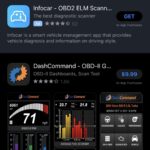Understanding your 2018 Dodge Durango’s On-Board Diagnostics II (OBD2) port is crucial for vehicle maintenance and performance monitoring. This port is not just for mechanics; it’s a gateway to your vehicle’s computer system, enabling you to diagnose issues, monitor performance, and even install helpful aftermarket accessories. Locating this port is the first step in unlocking a wealth of information about your Durango.
Finding the OBD2 Port in Your 2018 Dodge Durango
The OBD2 port in a 2018 Dodge Durango is typically located within the driver’s side interior. You won’t need any tools to access it. Specifically, you should look for the OBD2 plug location under the dashboard, in the vicinity of the steering column. It’s often positioned on the lower edge of the dash panel, making it easily accessible from the driver’s seat. The port is designed with a trapezoidal shape, featuring 16 pins, which is the standard for all OBD2 compliant vehicles in the US, including your Dodge Durango.
While the location is generally consistent across 2018 Dodge Durangos, it’s always a good idea to consult your vehicle’s owner’s manual for the definitive OBD2 plug location. The manual will provide a diagram and precise instructions if needed. In most cases, simply looking under the dash on the driver’s side will reveal the port.
What Can You Do with the OBD2 Port?
The OBD2 port serves multiple purposes, primarily centered around vehicle diagnostics and data access. Here are some common uses:
- Diagnostic Trouble Codes (DTCs) Reading: When your Durango’s check engine light illuminates, it signifies a problem. Connecting an OBD2 scanner to the port allows you to read these DTCs, which are codes that pinpoint the source of the issue. This empowers you to understand the problem before visiting a mechanic.
- Performance Monitoring: OBD2 ports can transmit real-time data about your vehicle’s performance. You can use scanners or apps to monitor parameters like engine speed (RPM), coolant temperature, fuel consumption, and more. This is valuable for both enthusiasts and those wanting to keep an eye on their Durango’s health.
- Emissions Testing: Many states use the OBD2 port as part of emissions testing. The port allows testing centers to quickly verify your vehicle’s emissions system is functioning correctly.
- Installation of Accessories: Certain aftermarket accessories, like the Z-Flash Plug and Play Flasher for Chrysler Vehicles, utilize the OBD2 port for power and data. These devices can enhance vehicle functionality without requiring complex wiring.
Utilizing the OBD2 Port for Vehicle Enhancement: The Z-Flash Flasher Example
One interesting application of the OBD2 port is for installing plug-and-play devices like the Z-Flash Flasher. This device, compatible with Chrysler vehicles including the 2018 Dodge Durango, uses the OBD2 port to activate vehicle lights in specific patterns. It’s a simple way to enhance vehicle visibility, particularly for safety or professional purposes.
The Z-Flash flasher exemplifies the convenience of OBD2 port accessories. It installs in seconds, requiring no tools or modifications. It operates by interpreting diagnostic signals from the OBD2 port, similar to how a mechanic’s scan tool works, but instead of diagnosing issues, it triggers light flashing patterns.
Addressing Concerns about OBD2 Port Flashers like Z-Flash
If you’re considering using an OBD2 flasher, you might have questions about its impact on your 2018 Dodge Durango. Let’s address some common concerns related to the Z-Flash Plug and Play Flasher:
- Computer Damage: The Z-Flash flasher, and similar OBD2 devices designed responsibly, do not emit voltage or alter your vehicle’s computer code in a harmful way. They operate much like plugging in a USB drive to a computer – a safe data exchange.
- Brake Light Functionality: Safety is paramount. Flasher modules like Z-Flash are designed to prioritize your vehicle’s essential safety signals. Your brake lights and turn signals will always function normally, overriding any flashing patterns when activated.
- Reverse Gear Issues: While the flasher won’t put your vehicle in reverse, some users have noted that activating reverse lights with flashers in certain vehicles might trigger the backup camera display due to factory wiring configurations. This is a minor, non-safety related side effect in some cases.
- Bulb Wear: Like any flasher that rapidly cycles lights, using an OBD2 flasher may slightly increase bulb wear over time, especially for standard halogen bulbs and particularly aftermarket HID bulbs. This is a general characteristic of flashing lights, not unique to OBD2-connected flashers. LED bulbs are generally more robust for flashing applications.
- Traceability: If you choose to remove the Z-Flash flasher, it leaves no trace of having been installed. It’s a temporary modification that doesn’t alter the vehicle’s core systems.
Conclusion: The OBD2 Port – A Useful Feature in Your 2018 Dodge Durango
The OBD2 port in your 2018 Dodge Durango is a valuable asset. It’s easily accessible, provides crucial diagnostic information, and enables the use of convenient accessories like the Z-Flash Plug and Play Flasher. Understanding its location and capabilities empowers you to maintain your vehicle, monitor its performance, and even enhance its functionality with simple plug-in devices. Whether you’re diagnosing a check engine light or adding visibility features, the OBD2 port is a key interface in modern vehicles.
